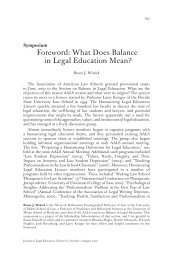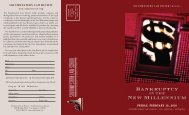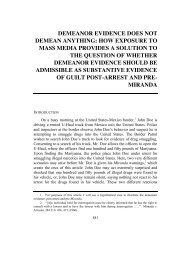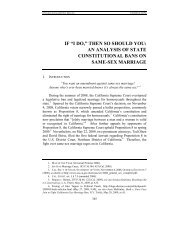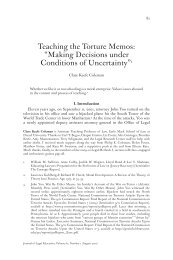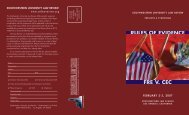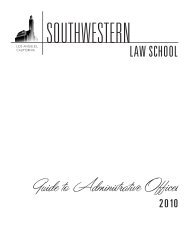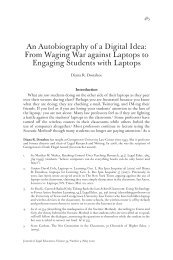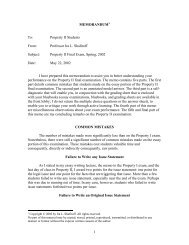What is Art? - Southwestern Law School
What is Art? - Southwestern Law School
What is Art? - Southwestern Law School
- No tags were found...
You also want an ePaper? Increase the reach of your titles
YUMPU automatically turns print PDFs into web optimized ePapers that Google loves.
114 J. INT’L MEDIA &ENTERTAINMENT LAW VOL. 4,NO. 2sent they have entered the tradition as if by simple chronologicald<strong>is</strong>tance.” 8C. <strong>Art</strong><strong>is</strong>tsEven though there <strong>is</strong> ample evidence of surviving art and artefactsand architecture from the dawn of civil<strong>is</strong>ation, there <strong>is</strong> little knowledgeof the identity of their authors. 9 It was not until the 17th century, chieflyduring the Golden Age of art and architecture in the Netherlands andduring the Qing Dynasty in China, that surviving records began to identifyart<strong>is</strong>ts as we have come to know them today—creating works on aspeculative bas<strong>is</strong> and offering them for sale in the open market.The interaction of social and economic changes, over time, provideskeys to our understanding of why societies gradually embraced thepractice of art<strong>is</strong>t as a d<strong>is</strong>tinct career—“of men who spend all theirtime in the production of useless things . . . who are exempted fromgrowing food.” 10 Urban dwellers have always relied on buying surplusesproduced by rural labour, and especially in cities where a significantmass of wealthy and powerful people—high net worth individuals—can also afford to patron<strong>is</strong>e original creations of the ‘art<strong>is</strong>t’.D. <strong>Art</strong> BusinessDirect patronage of the wealthy and powerful was the principalsource of income for creators of art and artefacts and architectureuntil the 17th century, or so. Scientific, technical, and industrial inventionsand developments from around th<strong>is</strong> era (and beyond, to date) increasinglyfacilitated the creation of artworks that were moveable andtransportable objects. Th<strong>is</strong> led to: the practice of collecting uniqueand desirable art objects, also and increasingly by the newly r<strong>is</strong>ing8. Id.9. “In the Middle Ages the individual art<strong>is</strong>t remains inv<strong>is</strong>ible behind the corporatefacades of church and guild. Greco-Roman and Chinese h<strong>is</strong>tories alone report in anydetail the conditions of individual art<strong>is</strong>ts’ lives. A few names and lines of text are allwe have about Egyptian dynastic art<strong>is</strong>ans. The records of the other civil<strong>is</strong>ations of antiquityin America, Africa, and India tell nothing of art<strong>is</strong>ts’ lives. Yet the archaeologicalrecord repeatedly shows the presence of connected series of rapidly changingmanufactures in the cities, and slower ones in the provinces and in the countryside,all manifesting the presence of persons whom we call art<strong>is</strong>ts.” KUBLER, note 6 supra.10. The Tomb of the Unknown Craftsman was an exhibition held at The Brit<strong>is</strong>h Museumin London in 2012. It was an installation of new works by Turner Prize winnerGrayson Perry, compr<strong>is</strong>ing objects made by unknown men and women throughout h<strong>is</strong>toryfrom the Brit<strong>is</strong>h Museum’s collection alongside new works by Perry; who explained:“Th<strong>is</strong> <strong>is</strong> a memorial to all the anonymous craftsmen that over the centurieshave fashioned the manmade wonders of the world. . .The craftsman’s anonymityI find especially resonant in an age of the celebrity art<strong>is</strong>t.” See http://www.brit<strong>is</strong>hmuseum.org/whats_on/exhibitions/grayson_perry/introduction.




